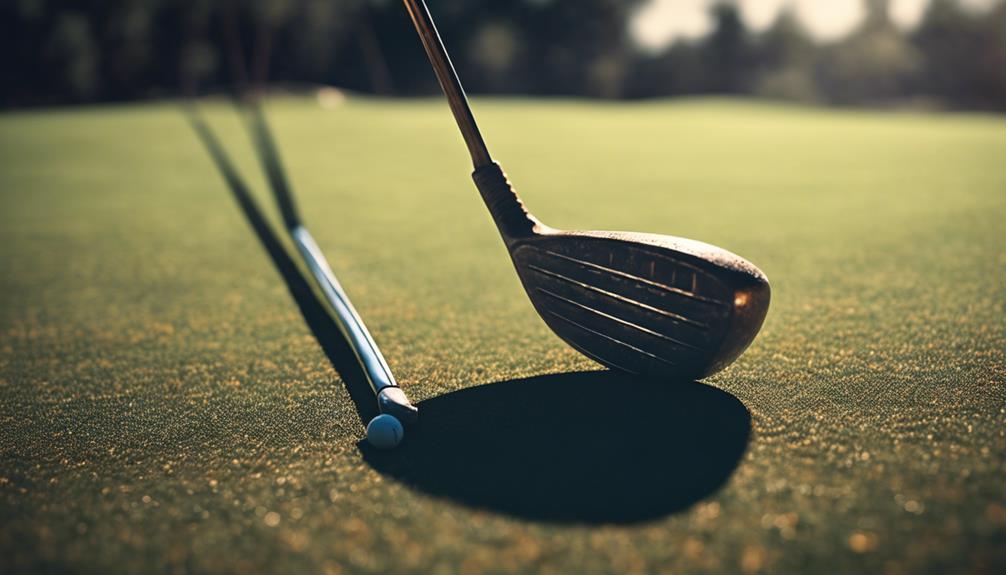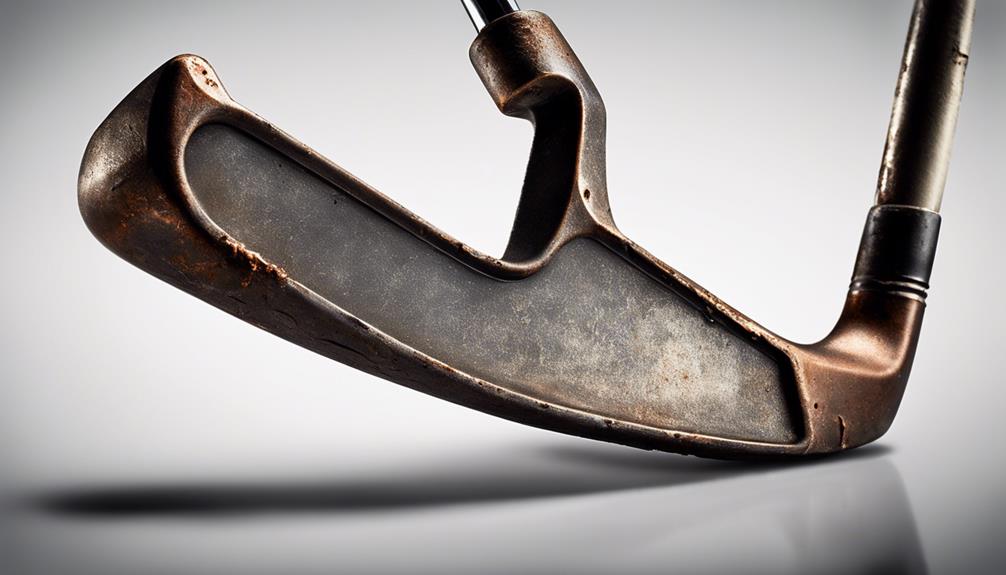- 7 Top Flite Golf Clubs XL for Improved Performance - September 28, 2024
- Top Flite Golf Clubs: Top 5 Reasons to Choose Them - September 28, 2024
- Top 3 Golf Club Fitters for a Perfect Swing - September 28, 2024
You're wondering if your golf clubs are too old, and it's a valid concern. If you're experiencing declining performance despite regular practice, noticing gaps in distance between clubs, or struggling to improve your game, it might be due to outdated technology. Visible signs of wear and tear, such as cracks or worn-out grooves, can also impact your game. Additionally, if you're not regularly cleaning and maintaining your clubs, dirt and debris can accumulate, affecting performance. Evaluating your clubs' condition and identifying these signs can help you determine if it's time to upgrade. Take a closer look to see if your clubs are holding you back from reaching your full potential.
Key Takeaways
- Declining performance despite regular practice may indicate that your golf clubs are outdated and hindering your game improvement.
- Visible signs of wear and tear, such as cracks or worn-out grooves, can impact your game performance and accuracy.
- If you're experiencing too much spin or gaps in distance between clubs, it may be a sign that your irons are outdated and need to be upgraded.
- Regular cleaning and maintenance can help extend the lifespan of your golf clubs, but if you're not seeing improvements, it may be time to consider new clubs.
- Outdated technology in your golf clubs can result in losses in distance, fewer greens hit, and higher scores, making it essential to assess their condition regularly.
Signs of Decline in Performance
As you regularly practice and play, declining performance despite your best efforts may be a telltale sign that your golf clubs are hindering your game improvement due to outdated technology. You're putting in the time, but your scores aren't budging.
This plateau can be frustrating, especially if you're not sure what's holding you back. It's crucial to examine the possibility that your golf clubs are no longer performing at their peak.
Take a closer look at your game, and you might notice some telltale signs that your clubs are the culprit.
Are you experiencing too much spin with drivers or irons, resulting in significant height but little distance? Are there noticeable gaps in distance between your clubs, making it difficult to find the right club for a specific shot?
These performance issues can be a sign that your golf clubs are no longer up to par. If you're struggling to improve your game, it may be time to weigh the benefits of upgrading to new clubs that can help you reach your full potential.
Visible Signs of Wear and Tear
Inspect your golf clubs regularly, and you'll likely notice visible signs of wear and tear that can affect their performance and accuracy.
Cracks, dents, or worn-out grooves on the club face are common signs of wear that can impact your game.
The frequency and intensity of use, as well as environmental factors like humidity and temperature, can contribute to the degradation of your golf clubs over time.
Regular cleaning and maintenance can help extend their lifespan by removing dirt, sand, and debris that can accelerate wear and tear.
When you inspect your clubs, look for signs of damage, such as scratches, rust, or corrosion.
If you notice any of these visible signs of wear, take action to address them promptly.
Regular maintenance can help prevent minor issues from becoming major problems that affect performance.
The Impact of Outdated Technology

You may be surprised to find that your trusty golf clubs, despite being well-maintained, are still holding you back due to outdated technology. Modern irons have faster ball speeds than older models, with some irons increasing ball speed by up to 2-3 mph. This can result in significant losses in distance, with drivers losing up to 10-15 yards and irons losing up to 5-10 yards.
| Outdated Technology | Impact on Game |
|---|---|
| Slower ball speed | Loss of distance (up to 10-15 yards with drivers, 5-10 yards with irons) |
| Less forgiving irons | Fewer greens hit, higher scores |
| Non-conforming grooves | Inconsistent roll, poor control around greens |
Outdated technology can also affect your overall score. Subtle improvements in irons can add up over a large number of holes, with some golfers experiencing up to a 5-stroke improvement per round. By upgrading to modern irons with advanced features like tungsten for increased forgiveness, you can improve your game and start seeing better results. By recognizing the impact of outdated technology, you can take the first step towards upgrading your clubs and taking your game to the next level.
Extending the Life of Your Clubs
Proper maintenance and storage techniques can substantially prolong the lifespan of your golf clubs, saving you money and ensuring consistent performance on the course.
When you're not using your set of golf clubs, store them in a dry, cool place away from direct sunlight. This will prevent the grips from drying out and the shafts from warping.
Regularly clean your clubs with a soft brush and mild soap to remove dirt and debris. Avoid using harsh chemicals, which can damage the clubheads and grips.
You should also periodically inspect your clubs for signs of wear, such as worn-out grips or loose shafts. Addressing these issues promptly can prevent more costly repairs down the line.
Assessing the Condition of Irons

When evaluating your iron set, you must assess the condition of each club, as this factor ultimately determines its performance, regardless of its age or technology. While modern irons boast impressive advancements, a well-maintained older iron can still hold its own. To accurately gauge your irons' condition, consider the following key aspects:
| Aspect | Impact on Performance |
|---|---|
| Groove wear | Affects ball spin and control |
| Face damage | Impacts ball speed and distance |
| Shaft condition | Influences swing tempo and stability |
| Cosmetic damage | Aesthetics only, no impact on performance |
Inspect your irons carefully, paying attention to any signs of wear or damage. If you notice significant groove wear or face damage, it may be affecting your game. On the other hand, if your irons are in good condition, they can still provide excellent performance. Remember, the condition of your irons, not their age, is the key determinant of their effectiveness as golf equipment.
When to Consider Upgrading
As you continue to play golf regularly, you'll likely notice that your clubs' performance starts to slip over time.
With club technology advancing rapidly, think about upgrading your irons every five years or so to take advantage of improvements in speed, forgiveness, and distance control.
Club Technology Advances
With each new generation of golf clubs, you're likely to find significant advancements in technology that can make a tangible difference in your game, particularly when it comes to irons.
By investing in new equipment, you can take advantage of the latest and greatest innovations, which can lead to improved performance.
For instance, modern irons boast faster ball speeds, resulting in up to 10-15 yards of extra distance.
Subtle improvements may seem minor, but they can add up over a large number of holes, making it worth considering upgrading.
Additionally, some modern irons feature tungsten, which increases forgiveness, making them a worthwhile upgrade for golfers who struggle with accuracy.
Even if your old irons are still performing well, upgrading to newer clubs can provide a fresh perspective and help to reignite passion for the game.
Performance Starts Slipping
Your trusty golf clubs, once the pride of your bag, start to show signs of fatigue, and their performance begins to slip, making it essential to recognize the telltale signs that it's time to think about upgrading.
As you continue to play, you may notice that your clubs are no longer delivering the same level of performance as they once did. This decline in performance can be attributed to various factors, including wear and tear, outdated technology, and changes in your swing.
You're experiencing a decline in distance and accuracy, despite regular practice and play, it may be time to explore new options.
You're noticing significant spin with drivers or irons, resulting in little distance despite high trajectory, which warrants an investigation into newer models.
You're struggling to find the right club for a specific shot, due to distance gaps between clubs, and it's worth weighing the benefits of an upgrade.
If you're experiencing any of these issues, it may be time to think about investing in new clubs that incorporate the latest technology and design.
With new clubs, you can expect to see improvements in distance, forgiveness, and spin rate, ultimately leading to better overall performance on the course.
Maximizing Club Lifespan and Performance
As you aim to get the most out of your golf clubs, you'll want to focus on proper maintenance and upkeep to extend their lifespan and optimize their performance.
By following a few simple guidelines, you can prevent damage, reduce wear and tear, and keep your clubs in top condition.
Club Maintenance Essentials
Regularly inspecting and cleaning your golf clubs is essential to maintaining their performance and extending their lifespan. As you use your clubs, dirt, grime, and other substances can accumulate, affecting the club's overall performance. By making cleaning a priority, you'll maintain your clubs in top condition.
Regular club maintenance is crucial to:
- Check for damage: Regularly inspect your clubs for signs of damage, such as dents, scratches, or worn-out grips. Addressing these issues promptly will prevent them from becoming more serious problems.
- Clean the grooves: Clean the grooves on your irons and wedges to guarantee proper ball-to-club contact. Use a soft-bristled brush and mild soap to remove dirt and debris.
- Store them properly: Store your golf clubs in a dry, cool place, away from direct sunlight. Avoid stacking them, as this can cause damage to the shafts or heads.
Extend Club Life
Properly caring for your golf clubs can substantially maximize their lifespan and performance, allowing you to enjoy consistent results on the course.
To extend the life of your clubs, you'll want to develop a regular cleaning routine. Use a soft-bristled brush to remove dirt and debris from the clubheads, and then wipe them down with a damp cloth. This will prevent corrosion and maintain the club's finish.
Store your clubs in a dry, cool place, away from direct sunlight, to prevent damage from UV rays. When traveling, consider investing in a high-quality club travel bag to protect your clubs from impact and scratches.
Regularly inspect your clubs for signs of wear, such as worn-out grips or damaged shafts, and address these issues promptly. By following these simple steps, you can extend the life of your golf clubs and guarantee they continue to perform at their best.
With proper care, your golf clubs can last for many years, providing you with consistent results and helping you to improve your game.
Frequently Asked Questions
How Do I Know if My Golf Clubs Are Still Good?
You determine if your golf clubs are still good by evaluating their condition, considering how they feel during your swing, and evaluating their performance, as worn-out clubs can hinder your game, regardless of age.
How Often Should Golf Clubs Be Replaced?
You should replace your golf clubs every 4-5 years to keep up with equipment evolution, ensuring you benefit from improved technology and maintain a good resale value, rather than holding onto outdated clubs.
How Do I Know When to Replace My Golf Irons?
You know it's time to replace your golf irons when you notice significant performance decline, despite proper maintenance. Consider iron fitting to optimize your swing, and look for advancements in shaft technology to improve distance and consistency.
What to Do With Really Old Golf Clubs?
You're holding onto vintage collectibles, wondering what to do with really old golf clubs that still evoke nostalgic swings; consider displaying them proudly, restoring for personal use, or selling to enthusiasts who'll cherish their historic charm.
Conclusion
As you stand on the course, your trusty clubs by your side, imagine them as a rusty old car – creaky, slow, and wheezing out a faint 'vroom' with each swing.
The once-sleek finish now dulled by scratches and dings, the shafts worn thin like a balding tire.
It's time to face the music: your clubs are old, outdated, and holding you back.
Don't let nostalgia get in the way of a better game – it's time to weigh the options of upgrading to a shiny new set that'll leave you driving like a Ferrari.




